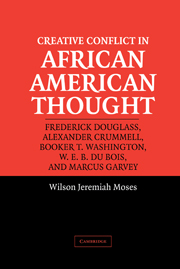Book contents
- Frontmatter
- Contents
- Acknowledgments
- Preface: Struggle, Challenge, and History
- 1 Introduction: Reality and Contradiction
- FREDERICK DOUGLASS: THE INDIVIDUALIST AS RACE MAN
- ALEXANDER CRUMMELL: THE ANGLOPHILE AS AFROCENTRIST
- BOOKER TALIAFERO WASHINGTON: THE IDEALIST AS MATERIALIST
- W. E. B. DU BOIS: THE DEMOCRAT AS AUTHORITARIAN
- 10 W. E. B. Du Bois on Religion and Art: Dynamic Contradictions and Multiple Consciousness
- 11 Angel of Light and Darkness: Du Bois and the Meaning of Democracy
- 12 Du Bois and Progressivism: The Anticapitalist as Elitist
- MARCUS MOZIAH GARVEY: THE REALIST AS ROMANTIC
- CONCLUSION: RESCUING HEROES FROM THEIR ADMIRERS
- Index
10 - W. E. B. Du Bois on Religion and Art: Dynamic Contradictions and Multiple Consciousness
Published online by Cambridge University Press: 07 November 2009
- Frontmatter
- Contents
- Acknowledgments
- Preface: Struggle, Challenge, and History
- 1 Introduction: Reality and Contradiction
- FREDERICK DOUGLASS: THE INDIVIDUALIST AS RACE MAN
- ALEXANDER CRUMMELL: THE ANGLOPHILE AS AFROCENTRIST
- BOOKER TALIAFERO WASHINGTON: THE IDEALIST AS MATERIALIST
- W. E. B. DU BOIS: THE DEMOCRAT AS AUTHORITARIAN
- 10 W. E. B. Du Bois on Religion and Art: Dynamic Contradictions and Multiple Consciousness
- 11 Angel of Light and Darkness: Du Bois and the Meaning of Democracy
- 12 Du Bois and Progressivism: The Anticapitalist as Elitist
- MARCUS MOZIAH GARVEY: THE REALIST AS ROMANTIC
- CONCLUSION: RESCUING HEROES FROM THEIR ADMIRERS
- Index
Summary
Of the five figures discussed in this book, Du Bois is the one most often subjected to a naive dialectic approach. His writings provide, in fact, an illustration of how the term “dialectics” can be inadequate for any study in the history of ideas, where multiple perspectives are always in opposition. He drafted a well-known dialectical passage applying the idea of internal contradiction to his own mentality, reducing himself to a double consciousness – “One ever feels this twoness – an American, a Negro; two souls; two thoughts; two unreconciled strivings; two warring ideals in one dark body, whose dogged strength alone keeps it from being torn asunder.” It is a crime that a presumably free society should ever have driven anyone to write such lines, for they cannot do justice to the complexity of any human consciousness.
A sketch in black and white can be almost tactile, as we realize on those happy but rare occasions when we view a classic film projected on a real-world screen. There is nothing, in other words, artistically deficient about the monochromatic. Confinement to black and white can force upon the photographer the discipline of artificial restraint, just as confining the poet to the structure of a sonnet may test creativity and produce interesting surprises. But sketches in black and white must always be recognized as abstractions from reality, as shadows of the world.
- Type
- Chapter
- Information
- Creative Conflict in African American Thought , pp. 185 - 196Publisher: Cambridge University PressPrint publication year: 2004



